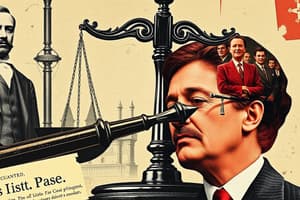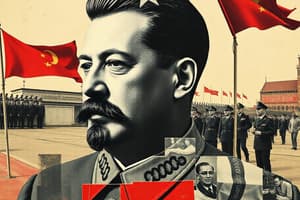Podcast
Questions and Answers
What is the ultimate goal of Marxism according to Karl Marx's ideology?
What is the ultimate goal of Marxism according to Karl Marx's ideology?
- Establish a classless society (correct)
- Increase the power of the bourgeoisie
- Create stricter government regulations
- Maintain the existing class hierarchies
According to Karl Marx, what is the role of the proletariat in the communist revolution?
According to Karl Marx, what is the role of the proletariat in the communist revolution?
- Continuing to work in factories as usual
- Becoming business owners themselves
- Supporting the bourgeoisie
- Violent rebellion against the capitalist state (correct)
How does Marxism (communism) differ from capitalism in terms of property ownership?
How does Marxism (communism) differ from capitalism in terms of property ownership?
- Communism abolishes private property ownership (correct)
- Capitalism promotes equal property distribution
- Communism allows unlimited private property accumulation
- Capitalism emphasizes communal property ownership
What is the main factor that drives the transition from socialism to communism in Marxist ideology?
What is the main factor that drives the transition from socialism to communism in Marxist ideology?
In a communist society according to Karl Marx, how are goods and services distributed?
In a communist society according to Karl Marx, how are goods and services distributed?
What distinguishes communism (Marxism) from other economic systems like feudalism and capitalism?
What distinguishes communism (Marxism) from other economic systems like feudalism and capitalism?
What was the primary focus of nineteenth-century reformers influenced by Socialism?
What was the primary focus of nineteenth-century reformers influenced by Socialism?
Which individual controlled almost all oil-related operations in the U.S. during the industrialization period?
Which individual controlled almost all oil-related operations in the U.S. during the industrialization period?
What was a significant development in transnational businesses during industrialization?
What was a significant development in transnational businesses during industrialization?
Which method of contraception was first considered safe and efficient during the industrialization period?
Which method of contraception was first considered safe and efficient during the industrialization period?
Why did many Europeans migrate to the Americas during the 19th to early 20th century?
Why did many Europeans migrate to the Americas during the 19th to early 20th century?
How did industrialized regions experience demographic changes during the industrialization period?
How did industrialized regions experience demographic changes during the industrialization period?
Flashcards
Karl Marx's Vision
Karl Marx's Vision
Karl Marx envisioned a communist society where the proletariat, or working class, would overthrow the capitalist system and establish a classless society without private property or government control.
Bourgeoisie vs. Proletariat
Bourgeoisie vs. Proletariat
Marx believed that society was divided into two main classes: the bourgeoisie, who owned the means of production, and the proletariat, who worked for them. This conflict drove his theory of revolution.
Dictatorship of the Proletariat
Dictatorship of the Proletariat
According to Marx, after the revolution, the proletariat would establish a temporary 'dictatorship of the proletariat' to control the economy and transition to a classless society.
Factors of Production
Factors of Production
Signup and view all the flashcards
Socialism's Impact
Socialism's Impact
Signup and view all the flashcards
Trade Unions and Collective Bargaining
Trade Unions and Collective Bargaining
Signup and view all the flashcards
Capitalism and Classical Liberalism
Capitalism and Classical Liberalism
Signup and view all the flashcards
Monopolies, Trusts, and Cartels
Monopolies, Trusts, and Cartels
Signup and view all the flashcards
Transnational Businesses
Transnational Businesses
Signup and view all the flashcards
Demographic Transition
Demographic Transition
Signup and view all the flashcards
Migration of Europeans
Migration of Europeans
Signup and view all the flashcards
Urbanization and Birth Rates
Urbanization and Birth Rates
Signup and view all the flashcards
Study Notes
Marxist Ideology
- Karl Marx witnessed exploitation of industrial proletariat in 19th century Europe and wrote Das Kapital and The Communist Manifesto outlining his plan for creating a communist state.
- Marx's plan involves a conflict between bourgeoisie and proletariat social classes, a violent rebellion of the industrial proletariat, and the overthrow of the capitalist/democratic state.
- The workers seize control over factors of production and establish a temporary dictatorship of the proletariat, which controls all economic decision-making.
- As class hierarchies dissolve, a harmonious, classless society develops, and the need for government control eventually dissolves, leading to a truly egalitarian communist society without formal government institutions and laws.
Key Principles of Marxism
- A utopian economic system envisioned by Karl Marx and Friedrich Engels.
- Believed to be the final step in the natural evolution from feudal, mercantilist, and capitalist systems.
- All factors of production (land, labor, and capital) are controlled by the proletariat and shared equally for the benefit of everyone.
- Private property does not exist, and goods and services are shared based on need and ability.
Social Reform and Trade Unions
- Socialism had a major impact on 19th-century reformers, addressing issues of medical insurance, unemployment compensation, and retirement benefits.
- Trade unions formed for collective bargaining, leading to strikes to address workers' demands for higher pay, safer conditions, and shorter hours.
Development and Expansion of Corporations and Financial Institutions
- The ideas of Adam Smith and John Stuart Mill inspired capitalism and classical liberalism, the foundations of Western industrialization.
- Large corporations formed monopolies, trusts, and cartels to eliminate competition, keep prices and profits high.
- Examples of corporations include John D. Rockefeller's Standard Oil Co. and German firm IG Farben.
- Transnational businesses operated in more than one country, relying on financial institutions to support growth, such as stock markets, insurance, and limited liability corporations.
The Demographic Transition
- Industrialized regions experienced a marked decline in both birth and death rates due to better diets, improved disease control, and the smallpox vaccine.
- At first, mortality fell faster than fertility, but over time, declining birthrates led to lower population growth and relative demographic stability in industrial nations.
Population Growth
- Population growth drove Europeans to migrate to the Americas from the 19th to early 20th century, with 50 million crossing the Atlantic.
- Migrants included British, Irish, and Jews fleeing urban slums, poverty, and persecution.
Transcontinental Migration
- Many migrants entered the United States, with the male condom being a safe and efficient means of contraception, leading to declining birthrates.
- Raising children in urban areas was more costly than in rural society, and children were more likely to survive into adulthood.
Studying That Suits You
Use AI to generate personalized quizzes and flashcards to suit your learning preferences.





